Roast pork was not something I ate a lot of before we moved to the UK. We were roast lamb-on-a-special-occasion people, occasionally a large, rosy rump of beef for a crowd. But a feast of pig- that other white meat- was not something I grew up with.
I remember the first time I went to a pub in London and heard folks order scratchings. In my antipodean naivete I wondered why they were ordering lottery tickets with their pints. It didn’t take me long to become acquainted with that most British of snacks- slivers of crisp pork crackling, dunked in apple sauce. There are cheap nasty versions, sold in foil packets in pubs where your elbows stick to the bar if you lean too long. There are posh iterations, done in swish restaurants with a dash of irony- and then there are the sophisticated Mr Trotters, crafted by two men who know their food; Tom Parker Bowles and Matthew Fort.
These days a rolled pork roast with proper crackling is what I’ll most often turn to when I’m looking for a celebratory supper. It’s what we served on our very first white Christmas – (the recipe is in the book) – it’s stuffed with a riot of festive aromatics and served with a roasted pear relish. It’s what I’ll bust out on a Friday if The Hungry One has had a crummy week. And it’s what I’ll often make if our friend Tom is coming to tea (Tom being one of the world’s great fans of pork crackling).
So when one of my oldest friends and her husband just relocated to the UK (and handily for us, around the corner) a home cooked meal was called for. To me, there is no dinner that declares to the world weary ‘Welcome to London’ quite like roast pork , with apples, onions, cider and crackling with a side of apple sauce, mustard and mash. And so this meal was born.
There are many theories about what makes the best pork crackling- some filled with truth, others superstition. Here are some I’ve committed to over time.
1) You need to score the rind- hopefully a butcher will have already done this for you, but if not, use a stanley knife (and be very careful).
2) You don’t want more than 0.5 cm of fat underneath the skin. Any more than that and you will most likely have a degree of rubberiness to your crackling (and possibly more fat than most of us should ingest) . If there is more, open it up like a book and trim it out, before folding it back over and tying your roast.
3) Pour boiling water over the top of the rind before baking. This will help encourage the crackling to fan out, allowing air to circulate deep into the crevices.
4) After that, be sure to dry the rind very well. Paper towel is good. I’m a little obsessive, so I take to it with a hairdryer for a couple of minutes.
5) Salt it generously, into the scores- but only do this just before it’s about to go in the oven (otherwise the salt can help draw out extra moisture- and moisture is the enemy of crackling).
6) Have the oven very hot (but make sure it’s clean. A very hot oven, plus ancient drippings on the bottom will lead to a very smoky kitchen).
7) Serve the crackling sparingly.
Crackling is not something we should eat all the time. But it does have a certain charm. It goes better with cider or ales than most things. It has the same crisp appeal as autumn leaves under your feet. And it provides a much called for contrast to a soft and squishy meal of blonde meat, soft onions and downy apples.
This is a meal that heartily declares a welcome to the UK, or serves a dose of nostalgia for those who are missing its fair shores. It says ‘I thought enough of you to bring my hairdryer into the kitchen’. And it also whispers quietly; if you’re going to eat more than a sliver or two of this bronzed and blistered fat, you probably should schedule in a trip to the gym tomorrow.
Rolled Pork Shoulder with Apples, Onions and Perfect Pork Crackling
Serves 4
Shopping/foraging
1 kilogram rolled, boned pork shoulder (rind scored by the butcher)
1 tbsp fennel seeds
Sea salt flakes
80 grams of lardons/streaky bacon
12 baby/pickling onions/eschallots, trimmed and peeled
4 small apples, with a 1 cm deep cut around the equator – this will stop them bursting and losing their shape when roasted.
400 ml of apple cider
To serve: mash potatoes/ white bean puree/cauliflower puree and steamed greens.
Here’s how we roll
1) Preheat the oven to a screaming 250 C/485 F (make sure that the oven is relatively clean. If there’s fat in there, it’s going to smoke like blazes while it heats up).
2) Boil the kettle. Place the pork on a roasting rack, over the top of the sink and pour the boiling water over the top of the rind. The hot water will encourage the scores in the rind to open up further.
3) Dry the rind very, very well. You can do this with paper towel. For the obsessives among us, a few minutes with a hair dryer is particularly effective.
4) Rub the rind with a generous amount of salt and fennel seeds, encouraging both into the cracks.
5) Roast the pork for 35 minutes, until the crackling is burnished and bubbled.
7) Leave the oven door open for a few minutes to help the heat drop down to 120C/250F.
8) Line the bottom of a baking tray/ Dutch oven with the lardons, peeled onions and apples
8) Pour over the cider and then place the pork over the top of the apples/onions- using them as a trivet.
9) Roast the pork for 2 hours at the lower temperature, until the onions and apples have softened and you have a sweet porky jus at the bottom of the pot.
10 ) Serve slices of the pork, an apple and onions over white bean puree or mash potatoes. Drizzle the pan juices and lardons over the top. Serve with steamed greens and some apple sauce.

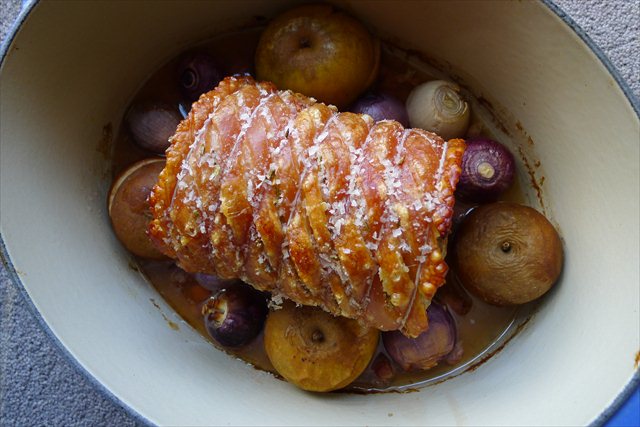

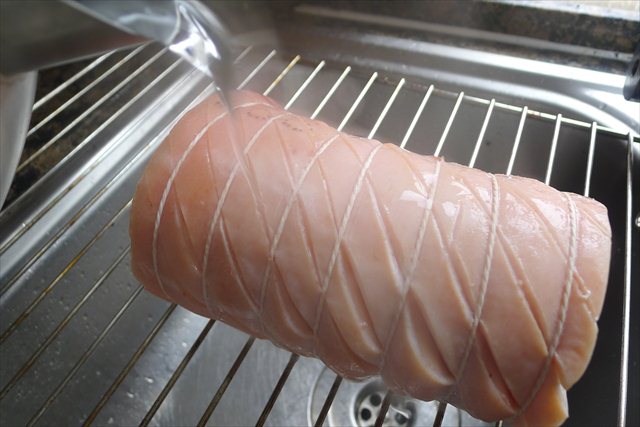

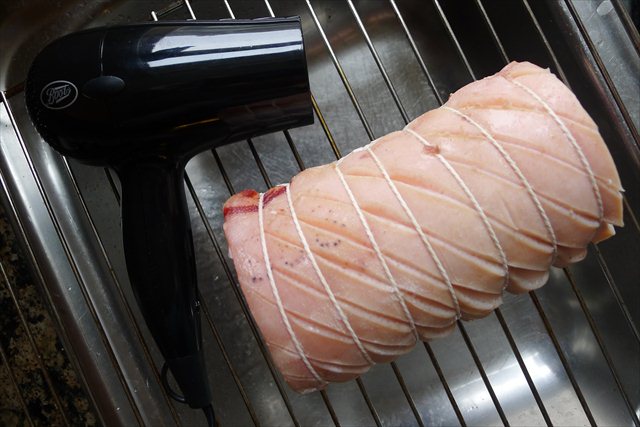
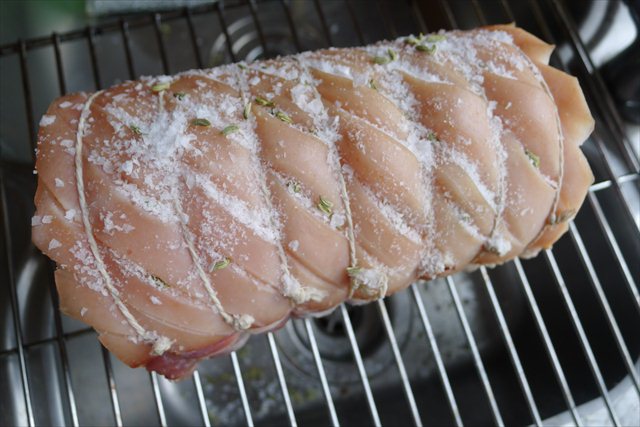
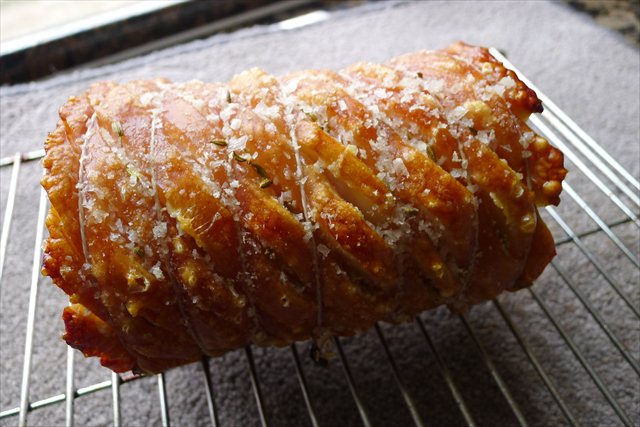


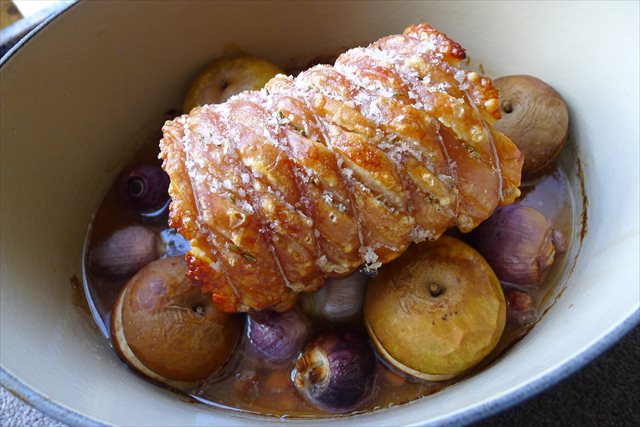

I love the way you finish that over the apples! Roast pork was always my birthday treat dinner.
Now that is some crackling! The hair dryer technique clearly works. 🙂
That looks brilliant. I always salt the pork, leave it for half an hour then use kitchen roll to dry up all the moisture that has come out. But sometimes it’s amazing and sometimes not, and I have to ‘pop’ the rest of the crackling under the grill. Will def try your way, as I also always struggle with sauce/gravy as I often get burnt juices in the tray. This looks yummo.
That crackling looks amazing… I have been known to eat more than two slivers and not follow it up with a trip to the gym…
Thank you for sharing your fantastic recipe 😀 I just made my first pork roast for our Sunday dinner (I know, I know – never try a new recipe when having guests over) and it is spot on! I couldn’t be happier with the crackling, you are amazing! Thanks again 🙂